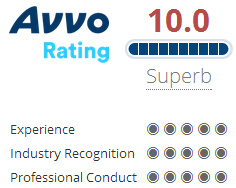Drunk driving or operating a vehicle while under the influence of drugs or alcohol is a problem in California that continues to claim innocent lives and injured scores of others. The California Office of Traffic Safety Annual Report for 2017 surmised that incidences of drunk driving increased from the previous year. The CDC reported that 1.8% of drivers (around 471,589 licensed drivers) in the state had operated vehicles after heavy drinking.
Jonathan Franklin DUI Attorney in Los Angeles is highly experienced in handling where clients are facing charges for drunk driving. We offer personalized representation to every client so you can benefit from expert advice tailored to your situation. In this article, we look at field sobriety testing and why these methods are not always accurate in determining impairment, and how we can challenge the DUI charge.
What are Field Sobriety Tests (FSTS)?
Field sobriety tests or Standardized Field Sobriety Tests (SFSTs) are a series of tests to see if alcohol or other substances impair the driver. The findings of these tests determine if there is probable cause to apprehend the driver and charge them with a DUI. There is no "pass" or "fail" in these tests, but the National Highway Traffic Safety Administration (NHTSA) requires officers to observe clues that indicate impairment when driving.
These findings alone are not sufficient for a DUI conviction, but they do open the way for a blood or chemical test to determine if the blood alcohol content is at 0.08% or higher. In the context of drunk driving fatalities, these drivers usually have a blood alcohol content that is higher than this limit.
California is keen on efforts to combat the scourge of drunk driving, and to this end, the state allows setting up sobriety checkpoints as police officers deem appropriate. If the driver's BAC reaches this acceptable legal limit or goes beyond, they will be charged with a DUI. Other efforts include the Know Your Limit Campaign informing the public on the horrific consequences of drinking and driving.
Standardized Testing Methods
There are many kinds of field sobriety tests, and the police officers are at liberty to administer one or more tests at a DUI checkpoint. The standardized testing methods are voluntary, but there are penalties for declining to take a test. Also, California has implied consent law, and it applies to all licensed drivers at any time.
Standardized testing is aimed at detecting per se intoxication or sensible suspicion of driving while intoxicated with alcohol or drugs. The NHTSA has approved the following standardized testing methods for sobriety:
-
Horizontal Gaze Nystagmus (HGN)
The HGN test is one of the central components of field sobriety testing. It checks for involuntary jerking of one's eye when it gazes to one side or another. The term "nystagmus" refers to the involuntary jerking of the human eye, but the officers are only concerned with the horizontal nystagmus. This jerking becomes exaggerated when a suspect is impaired with alcohol, and this observation is used as evidence in a DUI case.
Being on prescription medication, mainly antidepressants and other hard drugs, can also cause too much eye jerking. When alcohol or other substances impair a person, they are unable to control sideways eye motion seamlessly adequately. Since HGN does not have a noticeable effect on vision, a person displaying these exaggerated jerking is usually oblivious.
The accuracy of this HGN test depends on how well it is conducted, but findings are still debatable. It must be done in a well-lit area, or the officer will use a flashlight to illuminate the eyes and observe. The officer must ask if you have contact lenses or have any medical condition that could skew the results — for instance, poor circulation, hearing problems, knee injury, new surgical procedures, etc.
The officer will then start the process by placing a pen or similar object 12 to 15 inches away from your eyes. You will be asked to follow the movement of this object from one side to another.
The officer will be checking for the following clues:
- Failure to follow the object seamlessly as it moves from the midpoint of the face to the side. If your eyes are jerking, then it is a sign of impairment.
- If you portray distinctive nystagmus at maximum deviation, that is, having a dissimilar jerking after being held toward the further side of your ear for four seconds.
- If the onset of nystagmus happens before moving the object at 45 degrees from the midpoint of the face, for example, does the eye jerk before the pen is 45 degrees from the center of your face?
How Can I Challenge the Eye Test?
Findings from the NHG test inform the patrol officer about possible impairment by alcohol or other substances, and many states deem these results scientific and, therefore, admissible in court. The prosecuting attorney will need to prove the test was conducted as per NHTSA guidelines, and if not, the findings are not legitimate.
The NHTSA acknowledges that too much jerking of the eye can also be attributed to other factors such as the movement of inner ear fluid or neural activity. While these factors and natural occurrences are not familiar, your lawyer can base their argument on them. Medical reports such as previous neurosurgery can help exonerate you from frivolous DUI charges.
Jonathan Franklin DUI Attorney has helped many clients like you challenge the findings of the Horizontal Gaze Nystagmus. We can help you too so you don't have to live with the fallout from this charge. As your attorneys, it is our job to present this defense before trial, so the case is dismissed instead of trying our luck in open court.
-
The One-leg Stand
Police officers can also administer the one-leg stand test to determine if you are impaired to drive or not. Officers at a traffic stop using this test is used to determine if a driver has a blood alcohol content (BAC) level of 0.10% or more. If the findings indicate the BAC has surpassed the legal limit, the officer has probable cause to apprehend the suspect and charge them with a DUI.
The NHTSA has provided guidelines for conducting the one-leg stand, so officers don't make errors when administering the test. This test happens in two stages as follows:
-
Instruction Stage
The officer will give verbal instructions on how they will conduct the analysis and then demonstrate it, so you see firsthand. After that, they will ask if you comprehend the said instructions before they launch the next stage.
-
Performance Stage
You will raise one leg of your choice with your raised foot parallel and roughly six inches off of the ground. The officer will then ask you to count in thousands (one-one thousand, two-one thousand, and so on) with your hands to the side. You will do this while looking at your foot until they ask you to stop.
There are certain clues to look out for: swaying your body due to lack of balance, putting the raised foot down, using arms for balance, etc. If the officer observes at least two clues, they will fail you and arrest you for drunk driving.
How Can I Challenge the One-Leg Stand?
While the NHTSA has approved this test, it doesn't mean the results are always accurate. Your attorney will be hard at work finding ways of challenging these findings, so the DUI charges are dismissed. For instance, if you are 65 years or older, the chances are that you will struggle to stand on one leg for long. The same applies to people who are at least 50 pounds above average weight. The excess weight will make it harder to stand still without swaying their arms for balance.
Leg, back, or middle ear problems can also influence your performance. Traffic conditions can also distract your field sobriety testing such as high-speed traffic, a melee by pedestrians, traffic sounds and light signals, etc.
If you are charged with a DUI based on the one-leg stand test, we can help you challenge this accusation in court by presenting the necessary evidence. Police officers are also notorious for not adhering to due process, so they make seemingly innocuous mistakes like not asking suspects to remove high heels.
Even when the due procedure is followed, the one-leg stand has only 65% accuracy in determining impairment. Jonathan Franklin DUI Attorney will question the validity of these findings so the prosecutor will have no other recourse but to drop the charges.
-
Walk-and-turn Test
This test was created by the National Highway Traffic Safety Administration (NHTSA) and the Southern California Research Institute to help police officers in catching impaired drivers. The walk-and-turn test is fundamentally a divided attention test where the suspect walks nine steps on a straight line. You must walk heel to toe until a stipulated distance then turns around and repeat the same movement until the starting point.
It is a mental task of listening to the officer's instructions and a physical task of following their instructions by walking to and fro along a straight line. The police officer will be checking for the following signs of impairment:
- If you are unable to maintain balance while the officer is issuing instructions
- If you commence walking before the officer is done giving instructions
- If you stop the process in an attempt to stabilize yourself
- If you are touching your feet heel-to-toe while walking to and fro
- If you sway your arms to maintain balance
- If you lose balance while turning to walk back to the starting point
- If you fail to take the required nine steps each way
Having two or more of the above indicators tell the officer that you could be impaired by alcohol or other substances like illicit drugs. If they tested your blood alcohol content, it would exceed the legal limit of 0.05% and, therefore, a candidate for DUI charge.
How Can I Challenge the Walk-and-turn Test?
As with other field sobriety tests that are certified by the NHTSA, the walk-and-turn test is only 68% accurate. Industry experts have criticized this test as being inaccurate and unreliable in detecting alcohol impairment as the officer makes subjective observations. What if their opinion is biased by factors like racial profiling or wanting to hit arrest quotas? This test, they say, is designed to fail and should, therefore, not be used as a tool to gauge impairment.
Weather patterns such as heavy rain, snow, gusty winds, freezing, etc. can distract your performance and result in inaccurate deductions. As your attorneys, we shall investigate how testing was done using the available evidence like dashboard camera recording and your account of events. If we suspect foul play, such police misconduct on the arresting officer's record, we shall file motions to dismiss the case.
Non-Standardized Testing
Apart from the three certified tests for impairment, there are other methods used to determine if drivers are impaired or not. These methods typically apply in states where findings from standardized testing don't apply in a court, or they are eventually declared inadmissible. Examples of these non-standardized tests include:
- Romberg Balance Test
- Finger-to-nose test
- Finger count test
- ABC test
- Hand pat test
- Numbers backward analysis
The outcomes of these tests are also subject to questioning, so you don't accept DUI charges when you could be declared innocent. Was the test done appropriately? Did you understand the instructions? Could there be extenuating factors that could lead to false results? Responses to these questions could exonerate you from going to jail or having your license suspended for drunk driving.
You could claim general lack of balance, fatigue, anxiety due to police interrogation, or other impairments that could be misconstrued as being under the influence of drugs or alcohol. Also, there is no benchmark for success in these tests, which makes it impossible to determine how you would have performed otherwise. With an adept lawyer by your side, you will not be taken advantage of by a highly punitive criminal justice system.
Find a Qualified DUI Attorney Near Me
Results from all three standardized tests are only 82% accurate, according to the NHTSA. Subsequently, officers will not have a true reflection of impairment or lack thereof, no matter how many times they administer testing. For this reason, you must retain an experienced DUI attorney to represent you when you are charged with drunk driving or risk facing harsh penalties and assessments. Jonathan Franklin DUI Attorney in Los Angeles has years of experience in handling such cases, and we promise to use our expertise well. Contact us at 323-464-6700 for a free consultation with the best legal minds in town.













